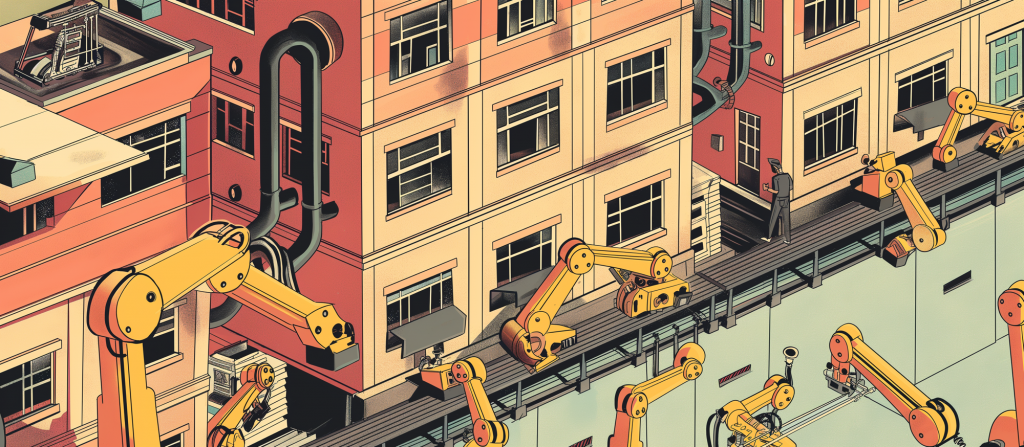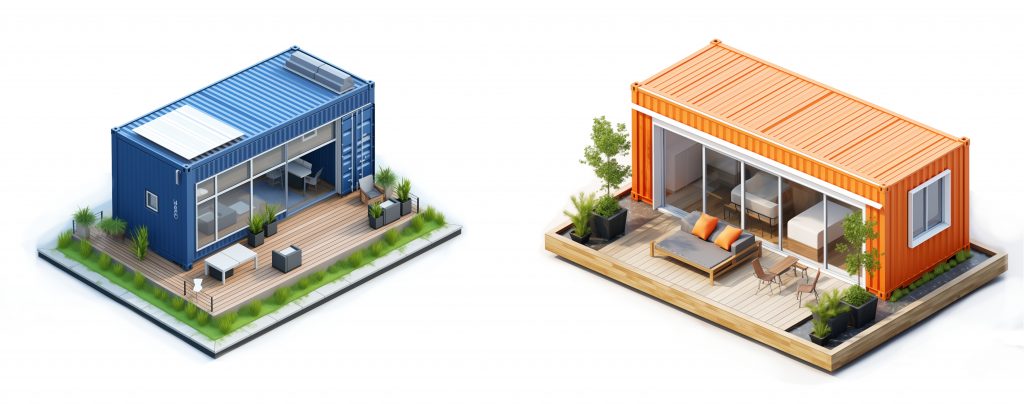How Modular Construction Can Help Fix The Housing Market
A spectre is haunting the housing market. No, I’m not just talking about Wall Street buying up homes, or AirBnB converting livable units into short-term rentals. I’m talking about supply scarcity. The rent is too damn high, and it’s– at least mostly- a supply and demand problem. We know that housing construction hasn’t kept pace with population growth. But we also know that the construction labor market is so constrained that it’s impossible to build anything in a reasonable time frame. We do, however, have a tried-and-true solution in the form of a thing called industrialized construction, a subset of which is the more commonly recognized term of modular construction.
Modular construction involves building buildings in components that are made in a factory instead of building everything on site.

The Value Proposition
There are a few basic value propositions behind modular construction, perhaps the most salient being that modular, at least theoretically, allows buildings to be built much faster (we figure time savings of up to 50%). You know that building down the street that seems like it’s taking forever to be finished? Day after day, you walk by and never see anyone working? That’s not just your imagination. That’s how it works in our current construction labor market, which is, however you slice it, several hundred thousand workers short. It’s a product of retirements and departures from the sector post-2008, silly restrictions on immigration, and many more factors.
The construction industry also severely lags its peers in productivity, having eked out miniscule gains in productivity since the 1940s, while other sectors have doubled or tripled productivity. Modular can address this by applying principles of industrial efficiency to building housing in a factory.
Another important value prop is that there is greater certainty around cost (lower likelihood of cost overruns) and, if a factory is operating at a high level of efficiency and volume, it’s possible to reduce costs versus conventional (we figure up to 20%). The question of cost savings is a complicated one, which we’ll explore more later.
Another added bonus is that modular allows for more rapid integration of novel technologies and building techniques that builders might struggle to implement on their own. This is, like all of the other value propositions, a question of scale and industrial precision. We’re thinking about things like low-voltage electrical systems, which have gained virtually no traction in residential construction in the United States, high-performance energy products or insulation materials, or integrated renewable energy features. Finally, a white paper we’re about to release is looking at more granular benefits in terms of what modular construction can do to fix the labor market, increase participation from diverse and underrepresented market segments, and more.
What It Is And What It’s Not
We use the terms “industrialized construction” (“IC”) or “industrialized offsite construction” as broader umbrella terms than simply calling something “modular,” which we think is a bit too vague. Realistically, most things built in the factory as a piecewise component of a structure could be considered either. There are a bazillion different typologies, but the most general taxonomy is to break it down into whether something is three-dimensional or two-dimensional:
Volumetric modular. These are essentially stackable components that build a building like Lego blocks. They’re usually transported on trucks. A tiny apartment could be made of as little as a single volumetric module, or it could be made out of several. They’re expensive to ship, but the advantage is that they’re much faster to assemble once on-site.
Panelized construction. Structural insulated panels are perhaps the best example of this. They can be described, in a somewhat oversimplified fashion, as a giant chunk of styrofoam sandwiched between two pieces of plywood. If that sounds appallingly simple, it’s because it is. SIPs operate on the same web-and-flange engineering princple as an I-beam. There are many alternatives to a traditional SIP. The advantage of these is that they’re much cheaper to transport but they can be a bit more tricky to assemble on-site, and additional finishing work needs to be done. Panelized construction may also include building wall assemblies and floor or ceiling assemblies that can also be transported flat, and these are often easily integrated with SIP construction.
Many IC projects make use of both 2D and 3D components. One of the manufacturers we work with, for example, makes volumetric boxes, but these need to have roofs and cladding added to finish the product once it’s on-site. This means that it’s possible to add, say, a SIP roof on top of the stacked modules, in what would be a hybrid of 2D (panelized) and 3D (volumetric) typologies. If your head is spinning reading this, imagine living and breathing this for six months straight.

What modular is not
Most of the modular market is geared toward single-family. Because of this, and because of the legacy term of “manufactured housing,” people usually think “trailer park.” While a trailer park (“manufactured home community”) is technically relying on industrialized offsite construction, “manufactured homes” are usually defined as things that must be built on a chassis because they are then able to be moved. While the trailers of today are not those of 50 years ago, the connotation of “trailer park” has undermined public perception of modular construction. As one self-described housing expert told me on Facebook recently, all modular construction is bad because modular homes are built on a chassis and are therefore more susceptible to tornado or hurricane damage! This is an issue with which we must contend in trying to fix the housing market using modular construction.
But the use of modular is increasingly popular for multifamily applications, and this is where we are focusing our efforts, because of the large economies of scale that are possible– and applicable for building a lot of high-quality affordable housing quickly.

So, like, tiny houses? Shipping container homes? ADU’s?
Accessory Dwelling Units are an important piece of the housing puzzle. But just like “tiny house” or shipping container homes, we shouldn’t act like ADUs are going to solve all of the world’s problems. Should we do everything we can to allow ADU development in every city in America? Yes. Why? ADUs are a tool that can help build more sustainable neighborhoods, more sustainable local economies, community and family wealth, and, of course, address a critical shortage of housing. But efforts to increase the adoption of ADU-friendly policy is an uphill battle among orthodox city policymakers, and this is challenging. The same is true with shipping container homes and tiny houses.
As an editorial aside (isn’t this why you read my blog?), my complaint about the CNU party people is the same complaint I have about a lot of the folks promoting ADUs and shipping container homes– it advances the single-family paradigm with little critical attention to questions of density. Density is a concept that everyone understands at a vague level, but not many people understand the direct relationship between having urban density and being able to also have nice things. If density is too low, you have car dependency, pollution, and traffic, plus fewer commercial or institutional amenities. That’s why we can’t ADU or cottage-court-on-greenfield-land our way out of the housing crisis.

If it’s “tried and true,” why isn’t everyone doing it?
Simply put, modular is a tough nut to crack, and this has made adoption tricky. It requires a balance of having sufficient demand for the product in the local market to keep what we call steady state manufacturing efficiency. It also requires having regulatory jurisdictions that will work with you instead of sending a building inspector out, charging you for an inspection, and then scratching his head and saying, “Huh! I’m not sure what I’m looking at!” (Have heard this story plenty of times). Finally, there are other challenges– like making sure construction financing stakeholders understand how modular works.
Or making sure insurers understand how the construction process works. Generally, there are fewer things that can go wrong with a modular project. But it’s vital to quantify and explain all of these things to all of the project partners, and this must be locked down in written, contractual language, while the financing element needs to be comfortable with the fact that modular projects don’t operate at all the way a conventional construction draw schedule operates.
At one level, everyone understands the theoretical value proposition– of saving a ton of time time, hopefully saving some money, and delivering a great product. At another level, fixing the housing market with modular construction is a complex and even abstract notion. It’s even hard for me to explain in a simple, short sentence what I do for work. I could say, for example: “My company is trying to make it easier to build housing.” That’s partially true, but a description that focuses on the IC ecosystem means a lot of people will say, “hey, so, can you build a building for me?” We can certainly help you build a building! But we’re neither real estate developers, nor housing developers, nor a construction company.
We’re thinking bigger picture– to ensure that everyone can do this more easily, more affordably, and at a bigger scale.
How We Get There.
Modular can at least make a huge dent in the housing crisis, if not fix the market in its entirety. But it’s going to require stakeholders to collaborate across sectors, it’s going to require funding, and it’s going to require a little thing we call regulatory innovation. In general, perhaps the biggest problem with the housing market isn’t that we’re not building modular, but rather that it’s really hard to build anything, anywhere. Fixing this sounds monumental, but it can fortunately begin at the local level: We need zoning reform. We need parking reform. And we need cities that want to build a lot of good infill housing and want to commit both funding and political power to make that happen.
Realizing all of this will require, of course, commitment of funding from a diversity of sources– to build out infrastructure, provide technical assistance to cities interested in making it happen, and designing and engineering actual product. Housing development agencies spend over $200,000 to build a single unit of affordable housing– with funding for our product platform, we think we could substantially lower that cost and substantially increase the rate of housing development.
We’ve already done a lot of the work of assembling the necessary partnerships, we’ve acquired some exploratory grant funding from a variety of federal sources, and, with the assistance of some municipal partners, we even have some potential sites picked out for pilot projects. In Michigan, we’re looking to do this on a regional scale, making use of the state’s legacy of manufacturing and industrial innovation alongside our legacies of resource production for things like steel and lumber. And we’re looking to facilitate the development on a large scale of good quality, energy-efficient, affordable housing– in Detroit and beyond.
If you’re interested in getting in touch to talk about how we can use modular construction in your regional market, you know where to find me.



